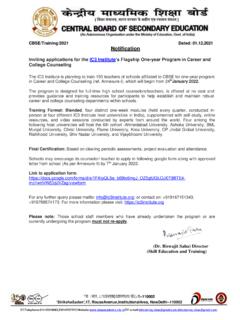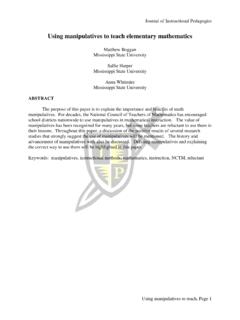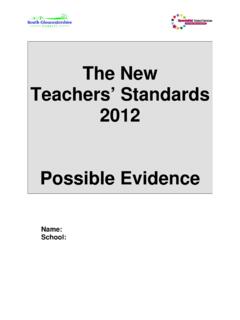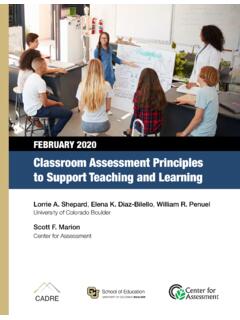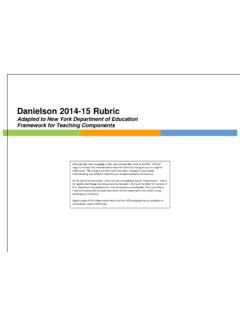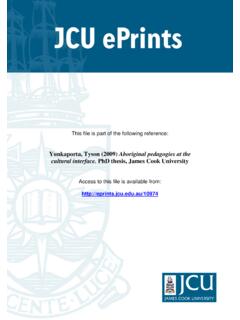Transcription of Towards a New End: New Pedagogies for Deep Learning
1 Towards a new end : New Pedagogies for deep Learning By Michael Fullan and Maria Langworthy On behalf of the global partnership June 2013 ii | Towards a new end : New Pedagogies for deep Learning Contributors Anthony Mackay, Australian Institute for Teaching and School Leadership, and Innovation Unit UK Carina Wong, Bill & Melinda Gates Foundation Greg Butler, Collaborative Impact Joanne McEachen, Collaborative Impact Kate Murray, Galway Education Jal Mehta, Harvard Graduate School of Education Jon K. Price, Intel Martina Roth, Intel Joanne Quinn, Michael Fullan Enterprises Michael Fullan, Michael Fullan Enterprises Maria Langworthy, Michael Fullan Enterprises Roy Zimmermann, Microsoft Kirsten Panton, Microsoft Steven Duggan, Microsoft Andreas Schleicher, OECD David Istance, OECD Kristen Weatherby, OECD Katelyn Donnelly, Pearson Education Simon Breakspear, Pearson Education Cathy Zier, Promethean Jim Wynn, Promethean John Hattie, University of Melbourne s Graduate School of Education Peter Hill Education Consultant June 2013 Published by Collaborative Impact Seattle, Washington.
2 USA Attribute to Collaborative Impact This work is licensed under a Creative Commons Attribute Unported License Towards a new end : New Pedagogies for deep Learning | iii Table of Contents Contributors ii Foreword iv Introduction 1 New Pedagogies for deep Learning Project 4 Our Theory of Action 5 Policy System Diffusion 7 Measures 8 Adoption of New Pedagogical Models 10 deep Learning Work 15 A Word on Technology 17 New Pedagogies for deep Learning Implementation Framework 19 References 28 iv | Towards a new end : New Pedagogies for deep Learning Foreword In early 1950 a talented group of French climbers led by Maurice Herzog set out to be the first team ever to climb an 8000 meter peak.
3 Several harrowing months later Herzog and one of his colleagues reached the summit of Annapurna in the Himalayas and achieved their goal. It was a remarkable story; much less remarked though is that before they could climb Annapurna, they had to find the mountain which was easier said than done. All they had to go on were poor maps and local inhabitants who naturally enough were more interested in finding passes between the mountains than reaching the summits. Finding the mountain took more than half the time Herzog and his colleagues had before the monsoons set in. All the drama that later followed was a consequence of those lost weeks. When I survey the literature on the new Learning goals, the future of pedagogy and the role technology might play in enabling students to achieve much more in school than is currently the case, the ascent of Annapurna keeps coming back to me.
4 Not only have we not been climbing our mountain; we haven't even found it yet. Until now. This paper from Michael Fullan and Maria Langworthy needs to be seen in that context. They do not claim to have climbed the mountain; I believe however they have helped us to find it. Drawing on Michael's excellent book, Stratosphere (2012), and the follow-up paper he wrote with Katelyn Donnelly, Alive in the Swamp (2013), Michael and Maria have mapped the landscape ahead. They describe the crisis facing global education systems and set out how systems will need to reconsider their Learning goals as well as their approach to change if they are to resolve the crisis and achieve high standards for all.
5 The Learning goals set out here go far beyond the essentials of literacy and numeracy and will require, for their fulfillment, new approaches to teaching and Learning , a new pedagogy in fact. The authors argue that unless a new pedagogy emerges the students in school will become increasingly bored and the adults increasingly frustrated. Moreover, the pace of development in technology and its application to Learning are creating new possibilities which, unless they are developed in school and for all, will simply be developed outside school and for some. A new divide would emerge and indeed this has already begun. Now we have found the mountain with the notable assistance of this paper our task as educators around the world is to climb it, and ensure that every student emerges from school ready for the extraordinary century that lies ahead.
6 By Sir Michael Barber, Chief Education Advisor, Pearson Towards a new end : New Pedagogies for deep Learning | 1 Introduction The crisis and there is no other word for it in public schooling is a function of the interaction of an enormous push-pull dynamic. The push factor is that students find schooling increasingly boring as they proceed across the grades. Studies from many countries show that among high school students less than 40% of upper secondary students are intellectually engaged (Jenkins, 2013; Willms et al., 2009). And, not unrelated, signs of teacher frustration are growing. For example, in the the percentage of teachers who are satisfied with teaching has plummeted from 65% to 38% from 2008 to 2012.
7 Teachers and students are psychologically if not literally being pushed out of school. Meanwhile prodigious technology is alluring all, kids and adults alike, to the digital world, not necessarily productively. Within this allure we are seeing exciting new Learning modes emerging from the interaction of pedagogy and technology. Education under these terms needs to be radically rethought partly to stop the boredom, but mostly to blow the lid off Learning , whereby students and teachers as partners become captivated by education day in and day out. The current situation is intrinsic to our societies transition to knowledge-based economies and global interdependency, enabled and accelerated by technology.
8 When highly complex systems change, chaos is a natural occurrence. Chaos, in turn, contains its own seeds from which new patterns develop. Amid the challenges, we have begun defining the what: new goals for Learning relevant to this new era. However, immediate and expansive attempts to innovate the how: the processes of education are urgently required. This focus on mobilizing innovation defines the vision of the New Pedagogies for deep Learning project: Global education stakeholders are working together in partnership to address a key education challenge: how educators can design and practice teaching and Learning that leads to more successful futures for all students. The partnership aims to articulate and demonstrate how the true potential for Learning can be realized through new Pedagogies in a technology-rich society.
9 2 | Towards a new end : New Pedagogies for deep Learning Relationships, practices, and measurements define the fundamental processes of education systems. The consensus among stakeholders in this project is that new Learning goals require changes in how relationships between students and teachers are structured, in how teaching and Learning is practiced, and in how Learning is measured. Using technology more effectively is essential to each of these processes. In much of the language and thinking on technology in education, there has been a quest for a holy grail that would transform education through technology. By now, it is clear that no holy grail exists; rather, technologies used to enable and accelerate specific processes can dramatically improve Learning , but its impact depends on how it is used.
10 As a recent report articulated, The context in which digital technology is deployed needs to change if we are going to drive better educational outcomes (Nesta 2013). Technology is quickly becoming ubiquitous in Learning environments from personal devices to the education cloud to digital Learning resources. This project focuses on the pedagogical innovations that will allow technology to achieve its potential to impact Learning . New Pedagogies for deep Learning : a global partnership seeks to renew our goals for education and Learning , to include skills that prepare all learners to be life-long creative, connected and collaborative problem solvers and to be healthy, happy individuals who contribute to the common good in today s globally interdependent world.

